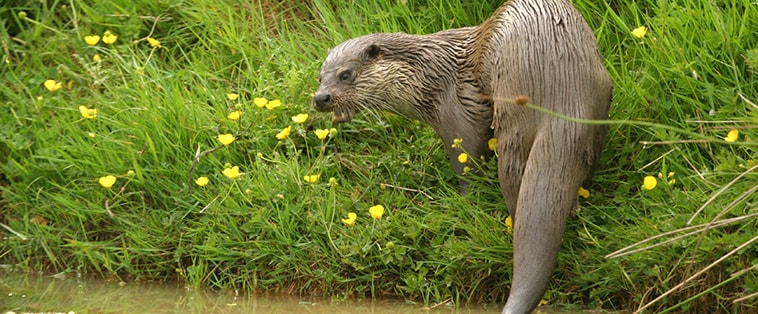Southern Ecological Solutions (SES) has a proven track record delivering projects where otter survey and mitigation is required. Pride and diligence is taken to meet client’s ecological obligations and commercial needs in a cost effective and pragmatic way.
SES also has a specialist in house implementation team with expert ecological surveying training allowing them to carry out works on sensitive sites. With experience in constructing new Otter holts, compensatory planting (habitat creation) and installation of otter proof fencing.
Otter Habitat and Ecology
There are 13 species of otter in the world but only one found in Britain which is the European or Eurasian Otter. Otters have medium to dark brown fur with a lighter under belly; they have 2 layers of fur a dry warm inner and a thick water proof outer layer made so by oily guard hairs. Otters can reach a length of 1.2 m and a weight of 10kg and live on average for 4 years in the wild.
Otters are largely nocturnal and are most active 3 to 5 hours after dusk; they can be found in all types of wetland habitats but mainly prefer rivers but can also occupy streams, lakes, marshes, ditches and even coastal areas. Otters are territorial which they fiercely guard; territories can range from 100m to 40km depending on the quality of habitat; male and females do not share the same territory but these may overlap slightly with territory boundaries often marked with faecal droppings (spraints) however these spraints are also left along other prominent positions (e.g. boulders, fallen tree trunks). Otters can breed all year round but only generally breed once every 2 years; with female Otters giving birth to 1-4 cubs which are dependent on their mother for up to 1 year . Otters rest in structures/vegetation called holts, which are usually tree stumps roots with underwater entrances (secure holts like these are preferred for breeding sites) but holts can also take the form of holes in rock falls, caves and cavities under bridges. Otters also rest in dense vegetation these are known as couches.
Otters can move across their territory on land via established ‘runs’ through bank side vegetation and in the water but catch most of the prey underwater which consists mostly of fish but amphibians, small mammals, molluscs and crustaceans all supplement an otters diet.
Legal Status and Planning Policy Protection
Otters are protected under section 9 of the Wildlife and Countryside Act 1981 (as amended) and regulation 40 of the Conservation of Species and Habitats Regulations (2010). Taken together it is illegal to:
- Deliberately kill, injure or capture any wild animal of European protected species;
- Deliberately disturb wild animals of any European protected species in such a way to be likely to significantly affect:
- The ability of any significant groups of animals of that species to survive, breed, rear or nurture their young; or
- The local distribution of that species.
- Recklessly disturb a European protected species or obstruct access to their roosts;
- Damage or destroys breed sites or resting places of such animals;
- Deliberately takes or destroys the young of such an animal;
- Possess or transport or any part of a European protected species, unless acquired legally;
- Sell, barter or exchange any part of a European protected species.
The maximum fine per offence is £5000; The Countryside Rights of Way Act 2000 (CRoW) amendment contains a provision for a custodial sentence of up to 6 months instead of, or in addition to, a fine. Along with a lengthy development delay until an appropriate mitigation programme has been agreed and completed.
The Natural Environment and Rural Communities Act 2006 (NERC) also lists the Otter as a species of principle importance under Section 41 and Section 40 requires every public body in the exercising of its functions (in relation Section 41 species) ‘have regard, so far as is consistent with the proper exercise of those functions, to the purpose of conserving biodiversity’. In addition, local authority planning departments should also meet the requirements of chapter 11: Conserving and enhancing the natural environment, of the Nation Planning Policy Framework (2012) which requires planners to not only protect biodiversity, but where possible to enhance. Obligations under planning policy represent a ‘material consideration’ to the local planning authority with ecological survey being required before planning permission can be granted.
Otter Surveys
Due the ecology of the Otter the most effective survey methodology is to survey for Otter field signs primarily spraints deposited at significant features within and on the boundary of the Otter’s territory. These spraints are long, black, cigar shaped droppings (3-10cm long). They often contain fish or amphibian bones; spraints have a distinguishable musky smell that is faintly sweet with a mucous/tar like jelly regularly left; exoskeletons of crustaceans can also be found in exposed areas. Otter surveys can be undertaken all year round.
Otter Mitigation
SES ecologists have designed and implemented various successful mitigation schemes that have involved the creation of new Otter holts, improving habitat connectivity, measures that minimise the disturbance in areas with existing Otter holts, compensatory planting and habitat creation to equal or positive degree for potential habitat loss, Otter proof fencing and converting of existing or new roads to minimise ‘road kill’ deaths which now constitute a significant threat to Otters.



